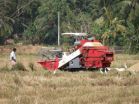(Press-News.org) Why zebras have black and white stripes is a question that has intrigued scientists and spectators for centuries. A research team led by the University of California, Davis, has now examined this riddle systematically. Their answer is published April 1 in the online journal Nature Communications.
The scientists found that biting flies, including horseflies and tsetse flies, are the evolutionary driver for zebra's stripes. Experimental work had previously shown that such flies tend to avoid black-and-white striped surfaces, but many other hypotheses for zebra stripes have been proposed since Alfred Russel Wallace and Charles Darwin debated the problem 120 years ago. These include:
A form of camouflage
Disrupting predatory attack by visually confusing carnivores
A mechanism of heat management
Having a social function
Avoiding ectoparasite attack, such as from biting flies
The team mapped the geographic distributions of the seven different species of zebras, horses and asses, and of their subspecies, noting the thickness, locations, and intensity of their stripes on several parts of their bodies. Their next step was to compare these animals' geographic ranges with different variables, including woodland areas, ranges of large predators, temperature, and the geographic distribution of glossinid (tsetse flies) and tabanid (horseflies) biting flies. They then examined where the striped animals and these variables overlapped.
After analyzing the five hypotheses, the scientists ruled out all but one: avoiding blood-sucking flies.
"I was amazed by our results," said lead author Tim Caro, a UC Davis professor of wildlife biology. "Again and again, there was greater striping on areas of the body in those parts of the world where there was more annoyance from biting flies."
While the distribution of tsetse flies in Africa is well known, the researchers did not have maps of tabanids (horseflies, deer flies). Instead, they mapped locations of the best breeding conditions for tabanids, creating an environmental proxy for their distributions. They found that striping is highly associated with several consecutive months of ideal conditions for tabanid reproduction.
Why would zebras evolve to have stripes whereas other hooved mammals did not? The study found that, unlike other African hooved mammals living in the same areas as zebras, zebra hair is shorter than the mouthpart length of biting flies, so zebras may be particularly susceptible to annoyance by biting flies.
"No one knew why zebras have such striking coloration," Caro said. "But solving evolutionary conundrums increases our knowledge of the natural world and may spark greater commitment to conserving it."
Yet in science, one solved riddle begets another: Why do biting flies avoid striped surfaces? Caro said that now that his study has provided ecological validity to the biting fly hypothesis, the evolutionary debate can move from why zebras have stripes to what prevents biting flies from seeing striped surfaces as potential prey, and why zebras are so susceptible to biting fly annoyance.
INFORMATION:
Co-authors on the study include Amanda Izzo and Hannah Walker with the UC Davis Department of Wildlife, Fish and Conservation Biology; Robert C. Reiner Jr., of the UC Davis Department of Entomology and the Fogarty International Center, National Institutes of Health; and Theodore Stankowich with the Department of Biological Sciences at California State University.
About UC Davis
For more than 100 years, UC Davis has been one place where people are bettering humanity and our natural world while seeking solutions to some of our most pressing challenges. Located near the state capital, UC Davis has more than 33,000 students, over 2,500 faculty and more than 21,000 staff, an annual research budget of over $750 million, a comprehensive health system and 13 specialized research centers. The university offers interdisciplinary graduate study and more than 100 undergraduate majors in four colleges — Agricultural and Environmental Sciences, Biological Sciences, Engineering, and Letters and Science. It also houses six professional schools — Education, Law, Management, Medicine, Veterinary Medicine and the Betty Irene Moore School of Nursing.
Scientists solve the riddle of zebras' stripes
2014-04-01
ELSE PRESS RELEASES FROM THIS DATE:
Should family businesses always keep it in the family?
2014-04-01
Montreal, April 1, 2014 – From the Murdochs to the Hiltons, families have long sought to keep their businesses in the bloodline. But new research from Concordia University's John Molson School of Business shows that's not necessarily the best method of management.
The recent study, published in the journal Entrepreneurship Theory and Practice, shows that if the family business is part of a traditional industry built on quality and reputation, a family member would make a good CEO. But if it operates in an industry that values innovation, and the firm has to stay on the ...
The human 'hairless' gene identified: One form of baldness explained
2014-04-01
It's not a hair-brained idea: A new research report appearing in the April 2014 issue of The FASEB Journal explains why people with a rare balding condition called "atrichia with papular lesions" lose their hair, and it identifies a strategy for reversing this hair loss. Specifically the report shows for the first time that the "human hairless gene" imparts an essential role in hair biology by regulating a subset of other hair genes. This newly discovered molecular function likely explains why mutations in the hairless gene contribute to the pathogenesis of atrichia with ...
Breast milk and diet up to 2 years old: A means of preventing the risk of child obesity
2014-04-01
This news release is available in French. Many studies have focused on the influence of breast-feeding on child health. From analysis of data from the ELANCE cohort, Marie Françoise Rolland-Cachera, former researcher at Inserm and her co-workers in the Nutritional Epidemiology Research Team (EREN) have shown that breast-feeding has a protective effect on the risk of obesity at 20 years of age. Researchers also emphasise that nutritional intake at the age of 2 years are critical in providing this beneficial effect. The results of the study are published in The Journal ...
One currency, one price?
2014-04-01
Economics has a "law of one price," which states that identical goods should, in theory, sell for identical prices — or else markets will even out the differences. Empirical work on the topic, however, has produced little evidence in support of this "law," and many studies showing deviations from it.
Now a newly published paper co-authored by two MIT economists, along with a colleague from the University of Chicago, presents evidence of a strong convergence of prices within the Eurozone, the region of European countries sharing a common currency. The divergence of product ...
First evidence that very small embryonic-like stem cells
2014-04-01
New Rochelle, NY, April 1, 2014 -- Rare, very small embryonic-like stem cells (VSELs) isolated from human adult tissues could provide a new source for developing regenerative therapies to repair complex tissues damaged by disease or trauma. The ability of these most-primitive, multipotent stem cells to differentiate into bone, neurons, connective tissue, and other cell types, and the proper criteria for identifying and isolating VSELs, are described in two articles in Stem Cells and Development, a peer-reviewed journal from Mary Ann Liebert, Inc., publishers. The articles ...
Survey shows spine surgeons need to screen more patients for anxiety and depression
2014-04-01
In a report published in the April edition of the Journal of Spinal Disorders and Techniques, a Johns Hopkins team says that only 10 percent of orthopaedic surgeons and neurosurgeons follow professional guidelines recommending routine psychological screenings of patients prior to major surgery for severe back and leg pain.
The oversight, researchers say, may pose a serious risk to patients' surgical recovery. Previous reports have tied bouts of depression to longer recuperations, delayed returns to work, more postsurgical complications and failures to comply with medication ...
Overcoming structural uncertainty in computer models
2014-04-01
Philadelphia, PA--A computer model is a representation of the functional relationship between one set of parameters, which forms the model input, and a corresponding set of target parameters, which forms the model output. A true model for a particular problem can rarely be defined with certainty. The most we can do to mitigate error is to quantify the uncertainty in the model.
In a recent paper published in the SIAM/ASA Journal on Uncertainty Quantification, authors Mark Strong and Jeremy Oakley offer a method to incorporate judgments into a model about structural uncertainty ...
Want spring allergy relief? Avoid stress
2014-04-01
ARLINGTON HEIGHTS, Ill. (April 1, 2014) – Stress doesn't cause allergies, but easing your mind might mean less allergy flare-ups this spring. According to a study published in the April issue of Annals of Allergy, Asthma & Immunology, the scientific journal of the American College of Allergy, Asthma and Immunology, allergy sufferers with persistent stress experience more allergy flares.
"Stress can cause several negative effects on the body, including causing more symptoms for allergy sufferers," said allergist Amber Patterson, MD, lead study author and ACAAI member. ...
Scientists ID genes that could lead to tough, disease-resistant varieties of rice
2014-04-01
As the Earth's human population marches toward 9 billion, the need for hardy new varieties of grain crops has never been greater.
It won't be enough to yield record harvests under perfect conditions. In an era of climate change, pollution and the global spread of pathogens, these new grains must also be able to handle stress. Now, researchers at Michigan Technological University have identified a set of genes that could be key to the development of the next generation of super rice.
A meta-data analysis by biologist Ramakrishna Wusirika and PhD student Rafi Shaik has ...
Pause the paunch and halt the hair loss
2014-04-01
In particular, the protein that activated hair follicle growth was shown to also inhibit fat production.
The world first research confirmed that changes in the hair growth cycle led to fluctuations in the thickness of the underlying fat layer of the skin – essentially meaning that the skin can regulate fat production.
The research was led by Professor Fiona Watt at King's College London in collaboration with Professor of Dermatology Rodney Sinclair from the University of Melbourne and Epworth Hospital.
Professor Sinclair said these findings could potentially be ...



